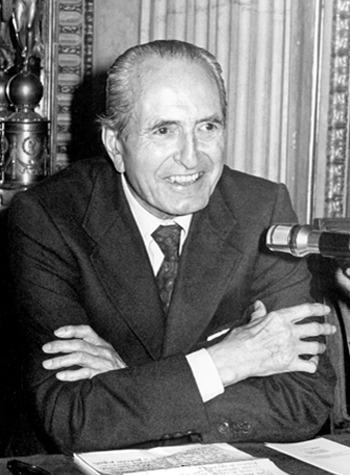Ignazio Gardella
Milan, 1905 - 1999
Ignazio Gardella (Milan, 1905) was born into a family of five generations of architects. He began studying civil engineering in 1931 at the Milan Polytechnic and graduated in architecture from the IUAV in Venice 19 years later. He is considered a pillar of the third generation of the Italian Modern Movement and stands out for his embodiment of Italian Rationalism. Architect and industrial designer, Ignazio Gardella has an extensive portfolio of architectural designs, as well as lighting and furniture pieces, being co-founder of the design company Azucena.
In 1929, Ignazio Gardella...
Ignazio Gardella (Milan, 1905) was born into a family of five generations of architects. He began studying civil engineering in 1931 at the Milan Polytechnic and graduated in architecture from the IUAV in Venice 19 years later. He is considered a pillar of the third generation of the Italian Modern Movement and stands out for his embodiment of Italian Rationalism. Architect and industrial designer, Ignazio Gardella has an extensive portfolio of architectural designs, as well as lighting and furniture pieces, being co-founder of the design company Azucena.
In 1929, Ignazio Gardella began working on architectural projects such as the Dispensario Antitubercolare (1929-1930), considered a reference of Italian Rationalism, and the Laboratorio Provinciale di Igiene, both in Alessandria. He laid the foundations for his future as an architect and was recognised for his work in the magazine "Casabella", belonging to the Rogers editorial group, well known for its innovation in Italian architecture. However, despite being one of the greatest exponents of this style, Gardella decided to break free of the creative constraints imposed by Rationalism. To this end, he made several trips abroad to learn about other styles. He began by travelling to Germany where he became acquainted with German architecture through the Frankfurt School and, in 1938, he travelled to Finland to meet the designer Alvar Aalto, Ilmari Tapiovaara s mentor. Equipped with an entirely new concept of design, that same year he returned to Italy and created the Milan-Green project that served as the basis, after the Second World War, for the AR Plan to rebuild the city.
After the Second World War, in 1945, Gardella, together with several young architects from Milan, founded the Studi Architettura Movement, aimed at defining the foundations of Italian Rationalism. The group promoted post-war Italian architecture, from building design to lecturing at universities. In 1947, Gardella began teaching at the IUAV in Venice, where he secured a chaired position in 1962.
Throughout the 1950s, Gardella carried out major projects that contributed to the reconstruction of Italy. These include the Galleria d Arte Contemporanea in Milan (1953), the Casa delle Zattere in Venice (1958) and the canteen for Olivetti in Ivrea (1958). In the years that followed he began tackling increasingly complex projects that required a great knowledge of both architecture and engineering. The Alfa Romeo offices in Arese (1972), the new headquarters of the Faculty of Architecture in Genoa (1989) and the Palace of Justice in La Spezia (1994) are stand-out examples.
Ignazio Gardella was critical of his own work, and often reflected on a desire to free himself from the canons of Rationalism. He saw sensitivity and a good eye as the instruments to create forms and thicknesses, and this rebelliousness resulted in the creation of his Digamma armchair, edited by Dino Gavina in 1957, and nowadays edited by Santa & Cole. The Digamma armchair (1957) is the clearest expression of Gardella s desire to overcome Rationalism: with a body (seat and back) in the rationalist style and ultra-rational articulations (arms and legs), it is a small masterpiece of extraordinary aesthetic and formal value.
In 1996, Ignazio Gardella was awarded the Medaglia d oro ai benemeriti della scienza e della cultura by the President of the Italian Republic. Voracious and dedicated, Gardella s career in architecture and design is one of national reinvention. His son, Jacopo Gardella, also became an architect.
